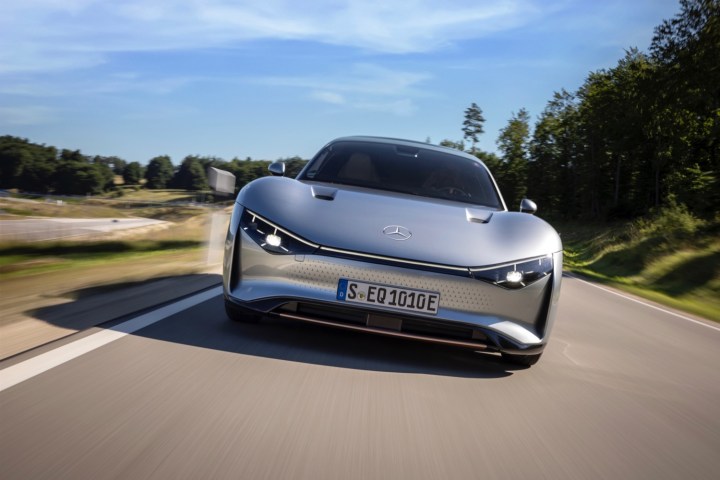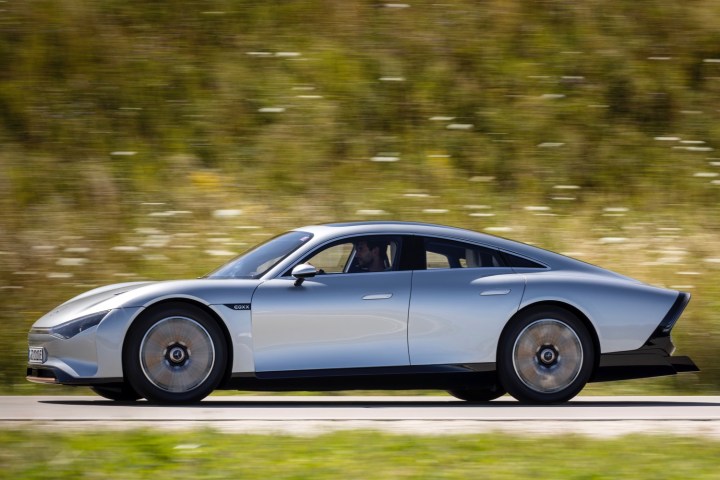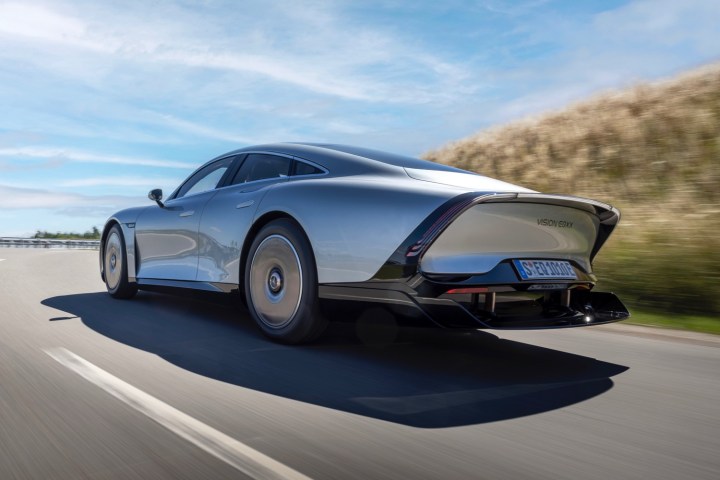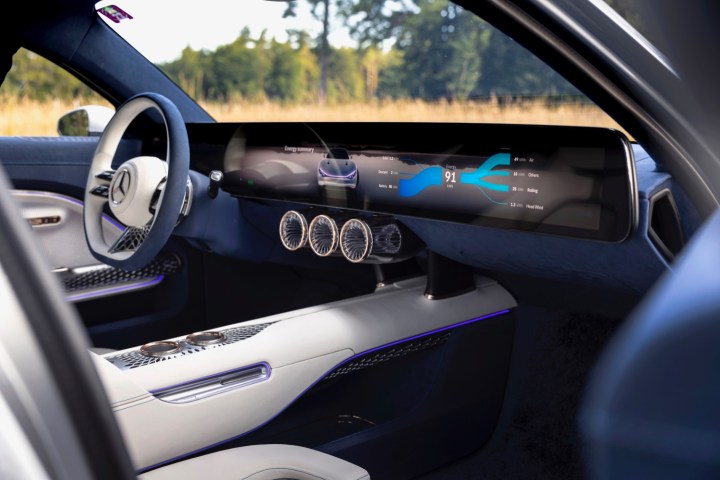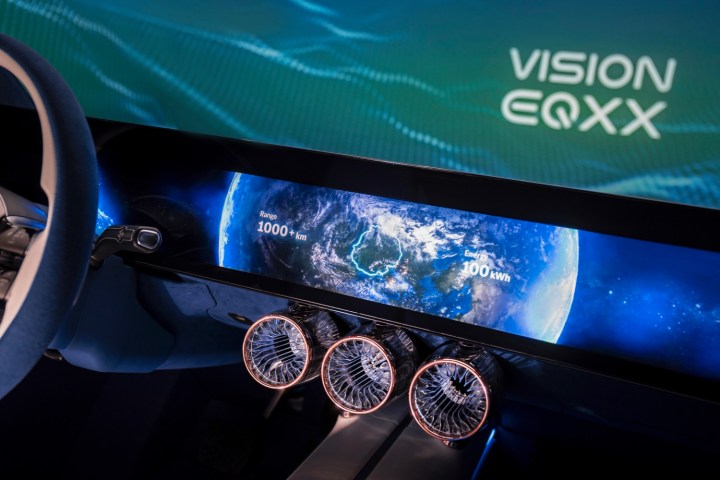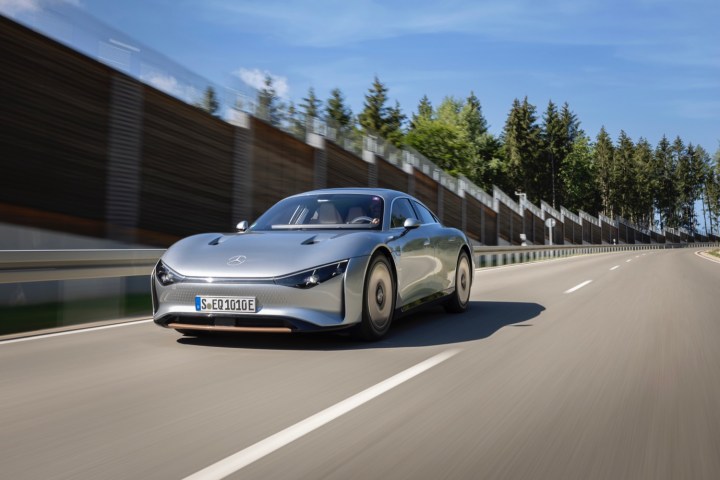It may have the familiar three-pointed star on its hood, but the Mercedes-Benz Vision EQXX is like no other car Mercedes — or any other automaker — has ever built.
The Vision EQXX is an electric concept car that debuted at CES 2022 earlier this year. But where many concept cars can’t even move under their own power, the Vision EQXX spent the months after its Las Vegas reveal setting range records with a pair of epic trans-European road trips. Because while most concepts focus solely on design, the Vision EQXX pushes the envelope in all areas, from the shape of its body to the code in its software.
Yet this isn’t some outlandish X-Plane for the road. The Vision EQXX is so approachable to drive that, despite being an unreplaceable multi-million-dollar one-off, Mercedes let us get behind the wheel. We spent a day at the automaker’s test track in Immendingen, Germany, to drive the EQXX and check out the cool tech that could make it the future of EVs.
Record-breaking range
The Vision EQXX was designed with a singularity of purpose normally reserved for race cars. But instead of focusing on how fast it could go around a track, the goal was to make it go as far as possible on a single charge. The benchmark was 1,000 kilometers (621 miles) without recharging.
“We didn’t have a long ledger of things this car was supposed to do,” Malte Sievers, project manager for the EQXX, told Digital Trends. “We were able to focus on efficiency.”
This isn’t some outlandish X-Plane for the road.
Built around that mentality, the EQXX completed a 626-mile trip in April 2022, making it from Sindelfingen, Germany, to Cassis, France, with the battery still at 15% charge (equivalent to about 25 miles of range) at the end of the trip. So Mercedes sent the EQXX out again, this time from Stuttgart, Germany, to England’s Silverstone race track. The car covered 747 miles before the battery ran down — and that included a few laps of the track.
“You need to optimize the whole package” to achieve that level of efficiency, Sievers said. That approach led to a car that not only obliterates range anxiety but brings the future of EVs into focus in a way no ordinary concept car or experimental prototype can.
Different, yet familiar
The Vision EQXX certainly looks the part of a futuristic car, thanks to its low stance, elongated tail, and solar roof. These elements give the car an extremely low coefficient of drag (cD) of just 0.17. For comparison, Mercedes’ most aerodynamic production car, the EQS sedan, has a 0.20 cD. Air shutters and an extendable rear diffuser increase aerodynamic drag somewhat when in use, but are necessary for cooling and high-speed efficiency, respectively.
On seeing the EQXX for the first time, we were struck not just by the design, but how finished the car looked. The headlights in particular looked like they could be production-car pieces. And while the long front and rear overhangs are unusual, that’s more a matter of current automotive styling trends than practicality. While definitely unusual, we think the EQXX would do quite well in any automotive beauty contest.
We were struck not just by the design, but how finished the car looked.
The EQXX even has four doors and roughly the same wheelbase as current Mercedes compact cars like the CLA-Class. The solar roof means there’s no back window, however, and the interior is quite cramped. We couldn’t imagine a human being actually fitting in the rear seats.
Unusually for a concept or prototype, that interior is fully finished, though. Sporting a full-width touchscreen, alien-looking crystal air vents, and funky purple carpets and trim (all made with sustainable materials), the design is something we wouldn’t mind seeing on an actual production car. Yet it also had everything we’d expect to find in a real production-car interior, from steering wheel controls to functioning air conditioning. It shows that more radical interior designs can work, at least from an ergonomic perspective.
Electron-sipping powertrain
In addition to a bespoke body and interior, the EQXX has a specially developed electric motor, battery chemistry, and cooling system. The numbers won’t cause a stir. The motor sends a middling 241 horsepower to the rear wheels, and the top speed is limited to 87 mph. But it was designed for efficiency, not high performance.
The battery pack has roughly 100 kilowatt-hours of energy-storage capacity, about the same as the current Mercedes EQS. But it features a different type of chemistry, with anodes that have more silicon than production battery cells. The pack also lacks the modular structure of conventional packs, meaning the energy-storing cells make up a larger percentage of its size, and a 900-volt electrical system, a higher voltage than the 400-volt and 800-volt systems used in current production cars.
The EQXX was designed for efficiency, not high performance.
However, the biggest departure from convention is the battery cooling system. Instead of the liquid cooling used in all current EVs, the pack is entirely air cooled. A plate underneath the car absorbs heat and uses the air flowing around the car to dissipate it. Mercedes notes that this is an entirely passive system, meaning it doesn’t use any energy to operate. It also saves weight by eliminating liquid coolant and the pumps and hoses needed to circulate it. The EQXX does have a heat pump, though, which draws heat from the electronics to warm the pack and cabin.
These elements alone provide a major boost in efficiency. Before driving the EQXX, we drove a Mercedes-Benz EQB (an electric SUV currently sold in Europe and coming soon to the U.S.) fitted with the EQXX powertrain. Where the standard European-market EQB has an energy-use rating of 16.2 kWh per 100 kilometers (62 miles), we averaged just 12.8 kWh/100 km.
Efficiency can be fun
The combination of this experimental powertrain and the EQXX’s chassis doesn’t just heighten efficiency. It also creates a unique driving experience.
The EQXX was downright fun to drive. At 3,500 pounds, it’s fairly light for an EV, and that helped imbue it with steering feel and a willingness to change direction we haven’t experienced in any production electric car. While not designed as a performance car, the EQXX felt nimble; we found ourselves able to take tight corners on Mercedes’ test track much faster than expected. Yet we were also more efficient than in the heavier, less aerodynamic EQB prototype, averaging 7.5 kWh/100 km. And that was with the energy-sapping air conditioning running.
Like all EVs, the EQXX uses regenerative braking to harvest energy, which also allows the car to decelerate without using the mechanical brakes. In the EQXX, different levels of regen can be selected using steering-wheel paddles. Toggling between these settings essentially works like downshifting a manual-transmission car, giving back some of the involvement lost with the elimination of clutch pedals and rev-matching. Some production cars have similar systems, but none as aggressive as the EQXX. During our test drive, we didn’t touch the brake pedal at all.
We were also encouraged to turn off the regen and coast when possible, since that uses zero energy. In a car as aerodynamic as the EQXX, which loses very little momentum to wind resistance, that’s a downright eerie experience. On a straightaway designed to replicate a stretch of Chinese highway, with our feet off the pedals, the EQXX maintained a steady 62 mph like it was on cruise control.
Battery-saving tech
Mercedes’ holistic approach to efficiency also applies to the infotainment system. But that doesn’t mean engineers skimped on anything.
As mentioned above, one screen runs the entire length of the dashboard, something we’ve yet to see even with the absurdly large screens of current production cars. The 47.5-inch, 8K display features gorgeous graphics, with a format that’s more desktop screen saver than anything automotive. Instead of the conventional menus and icons, information is simply overlaid on the background. That includes slick displays for efficiency-related info like energy consumption.
Despite being more lavish than anything currently used in production cars, this setup is also an energy-efficient option. Mercedes used the Unity game engine to generate graphics, which uses less energy than the pre-loaded graphics normally used in automotive infotainment systems, according to Mercedes. The screen also uses local dimming, so pixels displaying black are actually turned off. And to make the audio system more energy efficient, engineers relied solely on speakers in the seats for more targeted sound.
Everything in the cabin can also draw power from the EQXX’s solar roof, so you can swipe the touchscreen, listen to music, and run the air conditioning without drawing power from the main battery pack. This isn’t an original idea — you can already get a solar roof on a Hyundai Sonata Hybrid — but the EQXX shows that it can work even more effectively when scaled up.
An attainable vision of the future
The Vision EQXX is more than just another concept car, and it’s worth underlining that. Aside from some minor squeaks and rattles, we had no issues with it during our drive. Even some production-ready cars are plagued by software glitches and rattling trim pieces, so this is quite an achievement for a one-off, hand-built prototype.
But the EQXX is still very far from an actual production car. Many of the features that allowed it to cross Europe on a single charge might never make it to production. For example, engineers don’t know if air-cooled batteries will work in places like Sweden or Saudi Arabia. A larger, less-aerodynamic body shell would likely be needed as well both for interior space and to accommodate crash structures (the EQXX hasn’t been fully crash tested, and lacks airbags).
Yet the EQXX wasn’t built just for bragging rights. Mercedes plans to incorporate some of its features into a new generation of compact cars, although the automaker is being a bit vague on specifics for now. Lessons learned from the powertrain and aerodynamics could be translated to production vehicles, though. More importantly, Mercedes has shown how important it is to emphasize overall efficiency.
Range anxiety remains a major obstacle for electric cars, but increasing range with bigger battery packs isn’t sustainable. Bigger packs add cost and strain limited supplies of natural resources. They also require a dense network of high-power charging stations that doesn’t exist. Tesla and Lucid have shown what can be done with an efficiency-focused design, but it’s a lesson that legacy automakers have been slow to pick up on. The Mercedes EQS, while a great luxury car, isn’t exactly the last word in efficiency.
The Vision EQXX presents an alternative. Using a battery pack no larger than ones in current cars, it can travel farther on a single charge than most internal-combustion cars go on a tank of gas. And it does that without comprising driving dynamics, design, or tech. The name Vision EQXX is appropriate because this car presents a clear vision of what vehicles of the future could be like. Now it’s up to Mercedes to make that future a reality.
